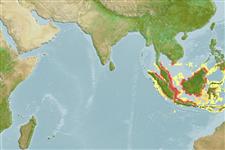Common names from other countries
Environment: milieu / climate zone / depth range / distribution range
Ecologie
marien; brak water; oceanodroom (Ref. 51243); diepte 1 - 20 m (Ref. 6898). Tropical; 9°N - 11°S, 94°E - 126°E (Ref. 189)
Indo-West Pacific: only Penang, Malaysia in the Indian Ocean; southern Thailand to Singapore, southern Kalimantan, Java and Sulawesi. Records of this species from India refer to the rather similar Thryssa kammalensoides.
Grootte / Gewicht / Leeftijd
Maturity: Lm ? range ? - ? cm
Max length : 18.0 cm TL mannelijk / geslacht onbekend; (Ref. 125279); max. gepubliceerd gewicht: 36.50 g (Ref. 125279)
Dorsale stekels (totaal) : 0; Anale stekels: 0; Anale zachte stralen: 30 - 33. Belly with 23 to 25 (rarely 24 or 26) keeled scutes from isthmus to anus. Maxilla moderate, reaching just to gill opening or a little beyond in large fishes; first supra-maxilla about half of second. A diffuse dark `saddle' on nape.
Presumably schooling and occurring mostly inshore. More data needed based on correct identifications.
Levenscyclus en paargedrag
Maturities | Voortplanting | Spawnings | Egg(s) | Fecundities | Larven
Wongratana, T., T.A. Munroe and M. Nizinski, 1999. Order Clupeiformes. Engraulidae. Anchovies. p. 1698-1753. In K.E. Carpenter and V.H. Niem (eds.) FAO species identification guide for fishery purposes. The living marine resources of the WCP. Vol. 3. Batoid fishes, chimaeras and bony fishes part 1 (Elopidae to Linophrynidae). FAO, Rome. (Ref. 9822)
Status op de Rode Lijst van het IUCN (Ref. 130435)
CITES (Ref. 128078)
Not Evaluated
Gevaar voor de mens
Harmless
Gebruik door de mens
Visserij: visserij voor eigen gebruik
Tools
Speciale rapporten
Download XML
Internetbronnen
Estimates based on models
Preferred temperature (Ref.
115969): 28.4 - 29.4, mean 29 (based on 536 cells).
Fylogenetische diversiteitsindex (Ref.
82804): PD
50 = 0.5000 [Uniqueness, from 0.5 = low to 2.0 = high].
Bayesian length-weight: a=0.00501 (0.00360 - 0.00697), b=3.12 (3.07 - 3.17), in cm Total Length, based on LWR estimates for this species (Ref.
93245).
Trofisch niveau (Ref.
69278): 3.4 ±0.4 se; based on diet studies.
Weerstandsvermogen (Ref.
120179): Gemiddeld, minimale populatieverdubbelingstijd 1,4-4,4 jaar (Preliminary K or Fecundity.).
Fishing Vulnerability (Ref.
59153): Low to moderate vulnerability (32 of 100).
